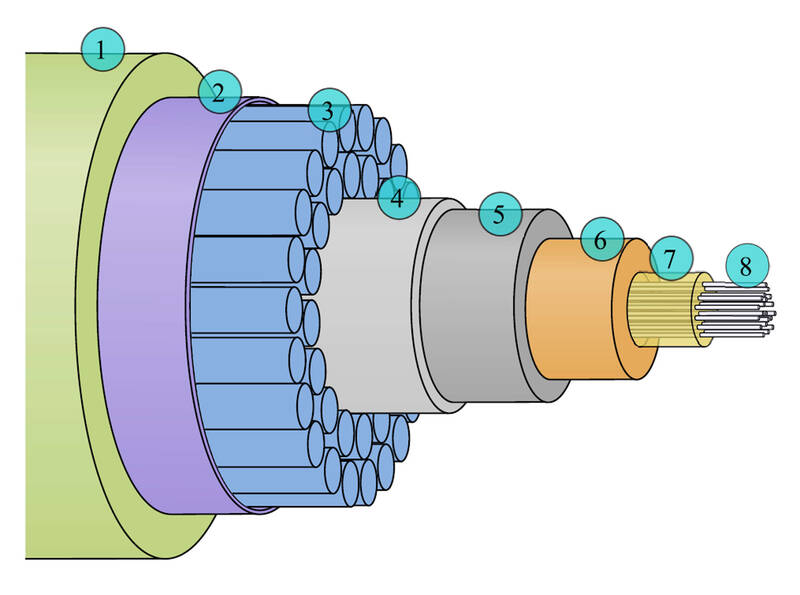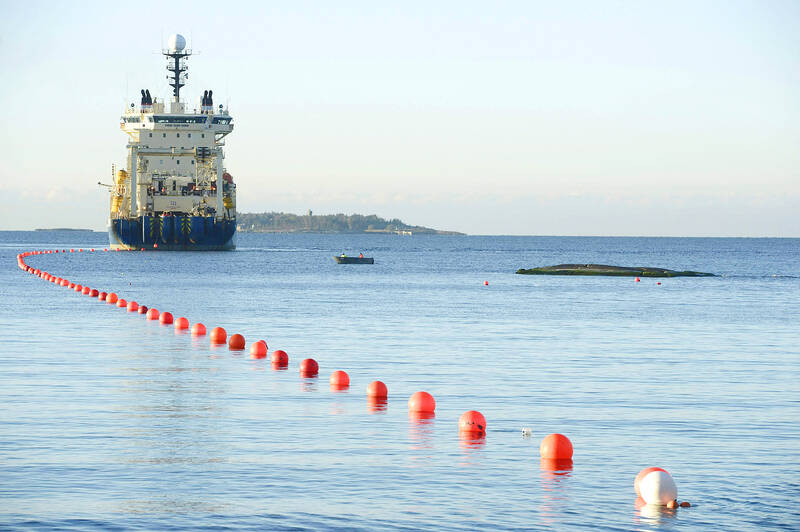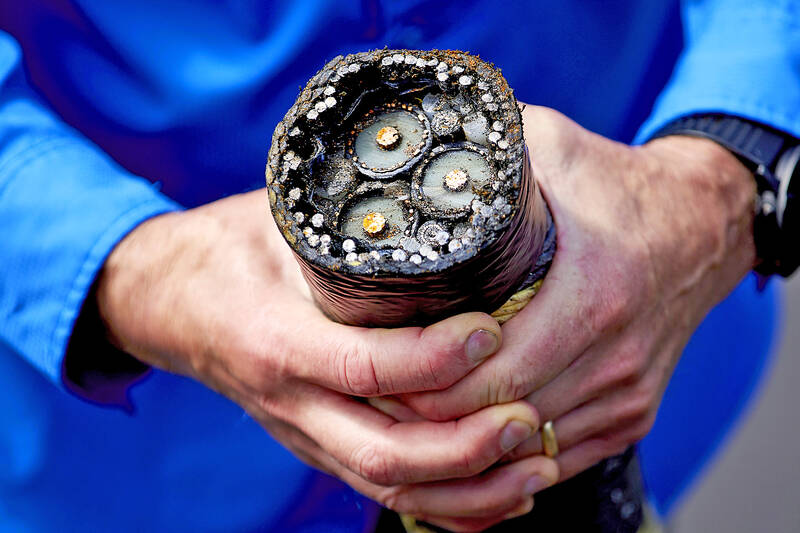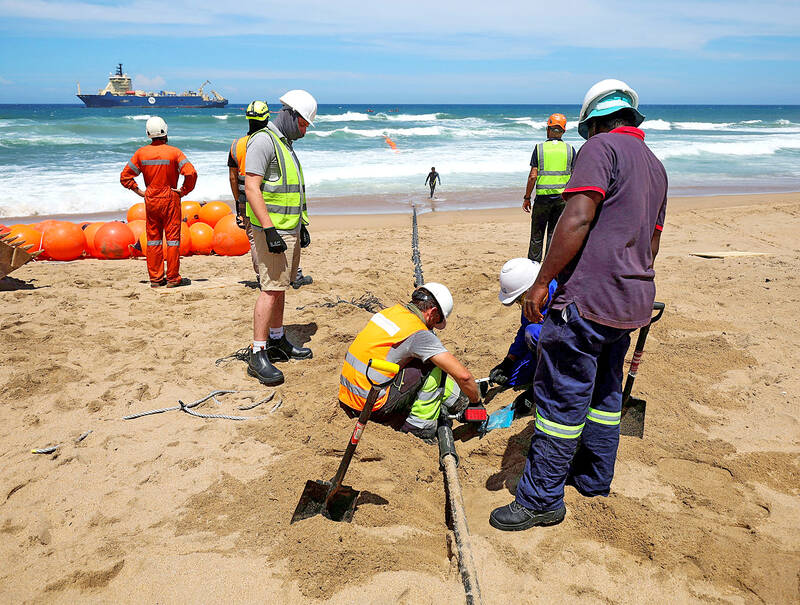Undersea cables are conductors wrapped in insulating materials and laid on the seabed. Their main functions are telecommunications or power transmission. The core of the undersea cables used for Internet signals is optical fiber, using light to transmit Internet signals.
Taiwan’s communications are currently handled by 10 domestic undersea cables and 14 international undersea cables. About 99 percent of Taiwan’s Internet bandwidth relies on undersea cables, making them Taiwan’s “digital lifeline.”
The demands on the cables’ bandwidth are only set to increase with the development of artificial intelligence (AI), which relies on the data fed into it. Today, data is an extremely important commodity.

Photo: Wikimedia Commons 照片:維基共享資源
With the development of the digital economy and the impact of the global pandemic, individuals, businesses and governments are highly dependent on Internet transmission, and so the cables are regarded as critical infrastructure for national security. Unfortunately, their high strategic value also makes them potential targets for attack.
As geopolitical tensions intensify in recent years, sabotaging undersea cables has become a tactical weapon in the “gray zone” between the rule of law and geography, due to the difficulties in law enforcement and accountability. However, they are also vulnerable to attack. Developing AI under such circumstances is like building luxury cars without properly maintaining the road infrastructure.
Finland and Estonia co-hosted a summit with NATO members from around the Baltic Sea in Helsinki on Tuesday last week to discuss measures to secure critical assets on the seabed. At the meeting, NATO Secretary-General Mark Rutte announced the launch of a mission dubbed Baltic Sentry, which will include frigates, maritime patrol aircraft and a fleet of naval drones to provide “enhanced surveillance and deterrence.”

Photo: AFP 照片:法新社
German Lieutenant-General Hans-Werner Wiermann, who previously led an undersea infrastructure coordination cell at NATO Headquarters, said no pipeline or cable can be guarded all the time. “The right response to such hybrid attacks is resilience,” he said. Laying more cables to add spare routings will allow critical pieces of infrastructure to keep working should a cable be cut.
To back up connections in the event of a failure, the Taiwan Space Agency in 2023 said it intends to launch its first self-made low-Earth orbit communication satellite next year and at least one more by 2028.
However, satellite communications are unlikely to replace submarine cables due to the large bandwidth gap. The bandwidth of a modern submarine cable can reach hundreds of Tbps per second (the MAREA submarine cable, for example, can reach up to 160 Tbps). Although satellites such as SpaceX’s Starlink can provide high-speed Internet, the bandwidth of a single satellite is usually only tens of Gbps. After being distributed among all users, the unit bandwidth is limited. After the completion of the Starlink full constellation project, Starlink is expected to provide approximately 20 Tbps of global bandwidth, only about 13 percent of a mainstream submarine cable.

Photo: AP 照片:美聯社
Li Jung-shian (李忠憲), professor of electrical engineering at National Cheng Kung University, pointed out that a resilient network is currently an important issue in Taiwan’s national security, especially since all military weapons are now controlled by information systems. Without information tools such as the Internet and satellite positioning, operations are bound to fail.
Satellite communications can make up for some of the connection needs in emergency situations, but it is difficult to replace the backbone position of undersea cables. Li believes that the Ministry of National Defense should establish a wartime routing and communication architecture, including backup undersea cables and satellite communications, wartime design of proxies and apps, VPN and proxy routing technology, and should conduct network resilience exercises.
(Lin Lee-kai, Taipei Times)

Photo: Reuters 照片:路透
海底電纜是用特殊絕緣材料包裹的導線,鋪設在海底,主要的功能是電信或電力傳送。用來傳送網路訊號的海底電纜,其核心是光纖,以「光」來傳輸訊號。
台灣目前由10條國內海纜與14條國際海纜擔起通訊重任。台灣約99%的網路頻寬都靠海纜,海纜的重要性如同台灣的「數位生命線」。
隨著人工智慧(AI)的發展——AI只能透過人們塞入其中的數據來滋養——對電纜頻寬的需求只會增加。如今數據是一種極其重要的商品。
由於數位經濟發展及全球疫情的影響,現今是個人、企業及政府皆對網路傳輸高度依賴的時代。因此,各國都將海底電纜視為國家安全的重要關鍵基礎設施,其高度的戰略價值也使它成為潛在的攻擊目標。
近年來隨著地緣政治緊張情勢加劇,破壞海底電纜成為遊走於法治與地域間的「灰色地帶」戰術利器,因其執法與究責之困難。海底電纜如此重要,卻又如此脆弱。在此狀況下誇言發展AI,如同道路基礎建設未妥善養護,而奢談造豪車。
有鑑於此,芬蘭及愛沙尼亞上週二在赫爾辛基共同主辦了峰會,與波羅的海週邊北約成員國討論保護海底關鍵資產的措施。北約秘書長馬克.呂特在會中宣布啟動代號「波羅的海哨兵」的行動,包括護衛艦、海上巡邏機與海軍無人機編隊,以「增強監視和威懾」。
曾在北約總部領導一個海底基礎設施協調小組的德國中將漢斯·沃納·維爾曼表示,任何管線或電纜都無法一直被保護著。他說:「對這種混合攻擊的正確應對,是恢復的能力」。因此必須鋪設電纜以增加備用路由,即便一條電纜被切斷,關鍵基礎設施仍能繼續運作。
台灣國家太空中心在2023年表示,為了在連線發生故障時有所備援,計畫在明年發射第一顆自製的近地軌道通訊衛星,並在 2028年前再發射至少一顆。
然而,衛星通訊難以取代海纜,因兩者頻寬差距很大,一條現代海纜的頻寬可達到每秒數百Tbps(如MAREA海纜,最高可達160 Tbps)。衛星(如SpaceX的Starlink)雖能提供高速網路,但單顆衛星的頻寬通常僅數十Gbps,分攤至所有使用者後,單位頻寬實際很有限。Starlink全星座計畫完成後預計可提供約20 Tbps的全球頻寬,僅相當於1條主流海纜的13%左右。
成功大學電機系教授李忠憲表示,韌性網路是目前台灣國家安全的重要議題,尤其現在所有的軍事武器都是由資訊系統來操控,若無網路、衛星定位等資訊工具,作戰一定失敗。
衛星通訊在應急情況下可彌補部分連線需求,但難以取代海纜的主幹地位。李忠憲建議,國防部應建立戰時路由與通信架構,包括備援海纜與衛星通訊、Proxy和App的戰時設計、VPN和代理路由技術,並應進行網路韌性演習。
(台北時報林俐凱)

In today’s digital age, every click and swipe generates data, and the need for reliable and efficient data management has become critical. This is where data centers come into play. Data centers include servers, storage drives, networking equipment, and other hardware to manage, process, and store vast amounts of digital information. __1__ For that reason, some companies are pursuing an unusual idea: placing data centers under the surface of the ocean. What makes underwater data centers cheaper than traditional land-based ones? For one thing, the cool temperature of the ocean means that companies can cut down on the high cost of

A: South Korean supergroup BTS member J-Hope, EXO member Xiumin and other various artists are set to tour Taiwan. B: Is J-Hope the first BTS member to visit as a solo singer? A: Yup, he’s going to stage two shows in Taoyuan over the weekend. B: All BTS fans, nicknamed “ARMY,” must be so happy. I wonder when the seven-member group can finally stage a comeback again. A: Well, the good news is the five members currently performing military service will all leave the army next month. So the fans’ long wait is about to end. A: 南韓天團防彈少年團BTS的J-Hope,和EXO的Xiumin等多位熱門歌手最近都要來台開唱。 B:

A: Apart from BTS’ J-Hope and EXO’s Xiumin, Hong Kong singer Eason Chan is holding six concerts in Kaohsiung. B: And versatile British musician Jacob Collier is visiting Taiwan for the first time, performing in New Taipei City tonight. A: US singer Lauv and rock band LANY will also stage individual shows in Kaohsiung next week. B: Plus, Singaporean singer JJ Lin will hold two concerts at the Taipei Dome in early June. A: Which show are you going to? A: 除了BTS的J-Hope和EXO的Xiumin,香港歌王陳奕迅正在高雄熱唱6場。 B: 而多才多藝的英國歌手雅各柯里爾首度訪台,今晚即將在新北開唱! A: 美國歌手洛夫、搖滾樂團藍尼下週也分別在高雄演出。 B: 此外新加坡歌王林俊傑則將於6月初,首次挑戰台北大巨蛋嗨唱兩場。 A: 你想去聽誰的演唱會? (By Eddy Chang, Taipei Times/台北時報張迪)

1. 我不夠快。 ˇ I wasn’t fast enough. χ I wasn’t enough fast. 註:enough用作副詞時,一般放在它修飾的形容詞或其他副詞後面。例如: The tea is hot enough.(茶是夠熱。) He did not work hard enough.(他不夠用功。) 但enough用作形容詞時,前置或後置都可以。例如: There is enough food (/food enough) for us. 2. 今晚七時我們將開董事會。 ˇ We are having a board meeting at seven o’clock this evening. ˇ We are having a board meeting this evening, at seven o’clock. χ We are having a board meeting this evening at seven o’clock. 註:如果有多個時間副詞,一般單位大的放在單位小的後面。例如: I was born in May 1939. The meeting was held at five o’clock yesterday afternoon. 但如果大的單位是說話者強調的重點,則可以放在前面,但後面要有逗號,表示停頓。例如: He arrived yesterday afternoon, at about five o’clock. 3. 我生於麻州波士頓。 ˇ I was born in Boston, Massachusetts. χ I was born in Massachusetts, Boston. 註:一般而言,地點副詞的位置,範圍大的放在範圍小的後面。例如: Before